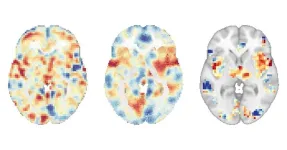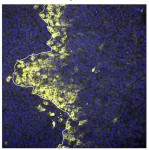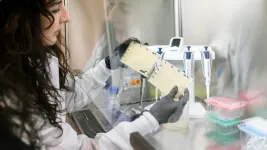(Press-News.org) Pain is a complex, multifaceted experience shaped by various factors beyond physical sensation, such as a person’s mindset and their expectations of pain. The placebo effect, the tendency for a person’s symptoms to improve in response to inactive treatment, is a well-known example of how expectations can significantly alter a person’s experience. Mindfulness meditation, which has been used for pain management in various cultures for centuries, has long been thought to work by activating the placebo response. However, scientists have now shown that this is not the case.
A new study, published in Biological Psychiatry, has revealed that mindfulness meditation engages distinct brain mechanisms to reduce pain compared to those of the placebo response. The study, conducted by researchers at University of California San Diego School of Medicine, used advanced brain imaging techniques to compare the pain-reducing effects of mindfulness meditation, a placebo cream and a “sham” mindfulness meditation in healthy participants.
The study found that mindfulness meditation produced significant reductions in pain intensity and pain unpleasantness ratings, and also reduced brain activity patterns associated with pain and negative emotions. In contrast, the placebo cream only reduced the brain activity pattern associated with the placebo effect, without affecting the person’s underlying experience of pain.
“The mind is extremely powerful, and we’re still working to understand how it can be harnessed for pain management,” said Fadel Zeidan, PhD, professor of anesthesiology and Endowed Professor in Empathy and Compassion Research at UC San Diego Sanford Institute for Empathy and Compassion. “By separating pain from the self and relinquishing evaluative judgment, mindfulness meditation is able to directly modify how we experience pain in a way that uses no drugs, costs nothing and can be practiced anywhere.”
The study included 115 participants, which consisted of two separate clinical trials in healthy participants, who were randomly placed into groups to be given four interventions: a guided mindfulness meditation, a sham-mindfulness meditation that only consisted of deep breathing, a placebo cream (petroleum jelly) that participants were trained to believe reduces pain and, as a control, one group listened to an audiobook. The researchers applied a very painful but harmless heat stimulus to the back of the leg and scanned the participants’ brains both before and after the interventions.
To analyze the participant’s brain activity patterns, the researchers used a novel approach called multivariate pattern analysis (MVPA), which uses machine learning to disentangle the many complex neural mechanisms underlying the experience of pain, including those stemming from specific heat stimulus, negative emotions and pain responses that are driven by the placebo effect. The researchers were then able to identify if mindfulness meditation and placebo engage similar and/or separate brain processes.
Although placebo cream and sham-mindfulness meditation lowered pain, the researchers found that mindfulness meditation was significantly more effective at reducing pain when compared to placebo cream, sham-mindfulness meditation and the controls.
They also found that mindfulness-based pain relief reduced synchronization between brain areas involved in introspection, self-awareness and emotional regulation. These parts of the brain together comprise the neural pain signal (NPS), a documented pattern of brain activity thought to be common to pain across different individuals and different types of pain. In contrast, the placebo cream and sham-mindfulness meditation did not show a significant change in the NPS when compared to controls. Instead, these other interventions engaged entirely separate brain mechanisms with little overlap.
“It has long been assumed that the placebo effect overlaps with brain mechanisms triggered by active treatments, but these results suggest that when it comes to pain, this may not be the case,” said Zeidan. “Instead, these two brain responses are completely distinct, which supports the use of mindfulness meditation as a direct intervention for chronic pain rather than as a way to engage the placebo effect.”
In modern medicine, new therapies are generally deemed effective and reliable if they outperform placebo. As the present study found that mindfulness meditation is more powerful than placebo and does not engage the same neurobiological processes as placebo, the findings have important implications for the development of new treatments for chronic pain. However, it will take more research to demonstrate these effects in people living with chronic pain as opposed to healthy participants.
In the long term, the researchers hope that by understanding the distinct brain mechanisms underlying mindfulness meditation, they can design more effective and accessible interventions that harness the power of mindfulness to reduce pain in people with various health conditions.
"Millions of people are living with chronic pain every day, and there may be more these people can do to reduce their pain and improve their quality of life than we previously understood.” said Zeidan. "We are excited to continue exploring the neurobiology of mindfulness and how we can leverage this ancient practice in the clinic.”
Link to study: Mindfulness meditation and placebo modulate distinct multivariate neural signatures to reduce pain - Biological Psychiatry
Co-authors on the study include Gabriel Riegner and Jon Dean at UC San Diego School of Medicine and Tor Wager at Dartmouth College.
This work was funded by the National Center for Complementary and Integrative Health.
# # #
END
Brain scans reveal that mindfulness meditation for pain is not a placebo
Mindfulness meditation engages separate neural pathways from the well-documented “placebo effect”
2024-09-05
ELSE PRESS RELEASES FROM THIS DATE:
Cancer research in space for life on earth
2024-09-05
WINSTON-SALEM, N.C. – September 5, 2024 — The Wake Forest Institute for Regenerative Medicine (WFIRM) is honored to announce its selection for a pioneering cancer research project that will take place aboard the International Space Station (ISS). The project, one of only five chosen through a competitive solicitation by the ISS National Lab in partnership with NASA, aims to explore the effects of microgravity on cancer development and treatment.
The project, led by Dr. Shay Soker, focuses on the use of organoids—miniature, simplified versions of organs grown in the lab from cells recovered from colorectal cancer patients. ...
Research spotlight: Radiology test can be used to diagnose immune checkpoint inhibitor-associated acute kidney injury
2024-09-05
How would you summarize your study for a lay audience?
Immune checkpoint inhibitors (ICIs) are a class of immunotherapy that have revolutionized the treatment of cancer. However, they can cause a wide variety of autoimmune toxicities, including immune checkpoint inhibitor-associated acute kidney injury (ICI-AKI). Differentiating ICI-AKI from acute kidney injury (AKI) due to alternative causes, which are common in cancer patients, is challenging without a kidney biopsy due to the risk of bleeding for some patients.
In this study, we ...
Rice’s Aryeh Warmflash awarded $1.6M NIH grant for research on early human development
2024-09-05
Researchers at Rice University are working to understand how a single cell evolves into the complex network of specialized cells that form the human body. Funded by a $1.6 million grant from the National Institutes of Health, the research team’s new study could advance our knowledge of developmental disorders and contribute to the future of regenerative medicine.
Led byAryeh Warmflash, an associate professor of biosciences and Cancer Prevention and Research Institute of Texas Scholar in cancer ...
Researchers make mouse skin transparent using a common food dye
2024-09-05
Seeing what’s going on inside a body is never easy. While technologies like CT scans, X-rays, MRIs, and microscopy can provide insights, the images are rarely completely clear and can come with side effects like radiation exposure.
But what if you could apply a substance on the skin, much like a moisturizing cream, and make it transparent, without harming the tissue?
That’s what Stanford scientists have done using an FDA-approved dye that is commonly found in food, among several other light-absorbing molecules that exhibit similar effects. Published in Science on ...
Groundwater use can be accurately monitored with satellites using OPENet, new study finds
2024-09-05
Drought is a widespread concern in the Western U.S., and water managers across the region are developing groundwater management plans to conserve the essential resource. Groundwater is often pumped to the surface to irrigate crops, and meters that measure the flow of pumped water have historically offered the best information on groundwater use. These meters are rare, however, so DRI scientists set out to determine whether OpenET, a platform that measures evapotranspiration using satellite data, could help fill this information gap.
The new study, published August 8th in a special issue of Agricultural Water Management, compared groundwater meter ...
New technology could lead to alternative treatments for antibiotic-resistant bacteria
2024-09-05
SAN FRANCISCO—As antibiotic resistance becomes an increasingly serious threat to our health, the scientific and medical communities are searching for new medicines to fight infections. Researchers at Gladstone Institutes have just moved closer to that goal with a novel technique for harnessing the power of bacteriophages.
Bacteriophages, or phages for short, are viruses that naturally take over and kill bacteria. Thousands of phages exist, but using them as treatments to fight specific bacteria has so far proven to be challenging. To optimize phage therapy and make it scalable to human disease, scientists need ways to engineer phages into efficient bacteria-killing machines. This would ...
Research shows queen conch populations in marine reserves replenish populations beyond the reserve in The Bahamas
2024-09-05
A new study published in Conservation Science and Practice uncovers how breeding populations of queen conch (Aliger gigas) within a protected marine reserve, where fishing is prohibited, sustain populations beyond the borders of the reserve. This research, based on surveys conducted in The Bahamas by Shedd Aquarium and Bahamian partners, identifies where additional protections could help to ensure the survival of future queen conch generations.
In The Bahamas, queen conch is an economic and cultural ...
Worcester Polytechnic Institute launches nation's first master’s program in explosion protection engineering
2024-09-05
Worcester, MA – September 5, 2024—Worcester Polytechnic Institute (WPI) has launched a groundbreaking Master of Science in Explosion Protection Engineering, the first program of its kind in the United States. Designed amid growing concerns about fire and explosion risk posed by manufacturing facilities and advancing technologies like electric vehicles and hydrogen fuel cells, the new program builds on WPI’s esteemed legacy in Fire Protection Engineering, which has been at the forefront of fire safety education and research since its inception in 1978.
“The demand ...
UC Irvine, USC scientists begin research effort for damaged brain region treatments
2024-09-05
Irvine, Calif., Sept. 5, 2024 — With newly awarded funding from the National Science Foundation, researchers at the University of California, Irvine and the Keck School of Medicine of USC will seek to revolutionize the treatment of neurological diseases through intelligent biocomputing. The four-year, $2 million grant is part of NSF’s Emerging Frontiers in Research and Innovation program, which funds cutting-edge science pushing the boundaries of human knowledge.
The premise of the UC Irvine-USC project is to combine engineering principles with stem cell research to treat damaged brain regions. The team’s long-term goal is to restore motor functions to patients ...
Risky combos of psychiatric drugs prescribed for young patients
2024-09-05
A new study reveals that young patients treated with psychiatric medications receive potentially dangerous combinations with concerning frequency.
Researchers from Rutgers Health and other institutions analyzed New York State Medicaid records for more than 141,000 patients receiving any psychiatric medication. Nearly 400 of them received at least one potentially dangerous combination t for one month or longer. Doctors refer to these as severe drug-drug interactions, and their use is typically considered "contraindicated" or recommended ...
LAST 30 PRESS RELEASES:
Scientists trace microplastics in fertilizer from fields to the beach
The Lancet Obstetrics, Gynecology, & Women’s Health: Taking paracetamol during pregnancy does not increase risk of autism, ADHD or intellectual disabilities, confirms new gold-standard evidence review
Taking paracetamol during pregnancy does not increase risk of autism, ADHD or intellectual disabilities
Harm reduction vending machines in New York State expand access to overdose treatment and drug test strips, UB studies confirm
University of Phoenix releases white paper on Credit for Prior Learning as a catalyst for internal mobility and retention
Canada losing track of salmon health as climate and industrial threats mount
Molecular sieve-confined Pt-FeOx catalysts achieve highly efficient reversible hydrogen cycle of methylcyclohexane-toluene
Investment in farm productivity tools key to reducing greenhouse gas
New review highlights electrochemical pathways to recover uranium from wastewater and seawater
Hidden pollutants in shale gas development raise environmental concerns, new review finds
Discarded cigarette butts transformed into high performance energy storage materials
Researchers highlight role of alternative RNA splicing in schizophrenia
NTU Singapore scientists find new way to disarm antibiotic-resistant bacteria and restore healing in chronic wounds
Research suggests nationwide racial bias in media reporting on gun violence
Revealing the cell’s nanocourier at work
Health impacts of nursing home staffing
Public views about opioid overdose and people with opioid use disorder
Age-related changes in sperm DNA may play a role in autism risk
Ambitious model fails to explain near-death experiences, experts say
Multifaceted effects of inward foreign direct investment on new venture creation
Exploring mutations that spontaneously switch on a key brain cell receptor
Two-step genome editing enables the creation of full-length humanized mouse models
Pusan National University researchers develop light-activated tissue adhesive patch for rapid, watertight neurosurgical sealing
Study finds so-called super agers tend to have at least two key genetic advantages
Brain stimulation device cleared for ADHD in the US is overall safe but ineffective
Scientists discover natural ‘brake’ that could stop harmful inflammation
Tougher solid electrolyte advances long-sought lithium metal batteries
Experts provide policy roadmap to reduce dementia risk
New 3D imaging system could address limitations of MRI, CT and ultrasound
First-in-human drug trial lowers high blood fats
[Press-News.org] Brain scans reveal that mindfulness meditation for pain is not a placeboMindfulness meditation engages separate neural pathways from the well-documented “placebo effect”







